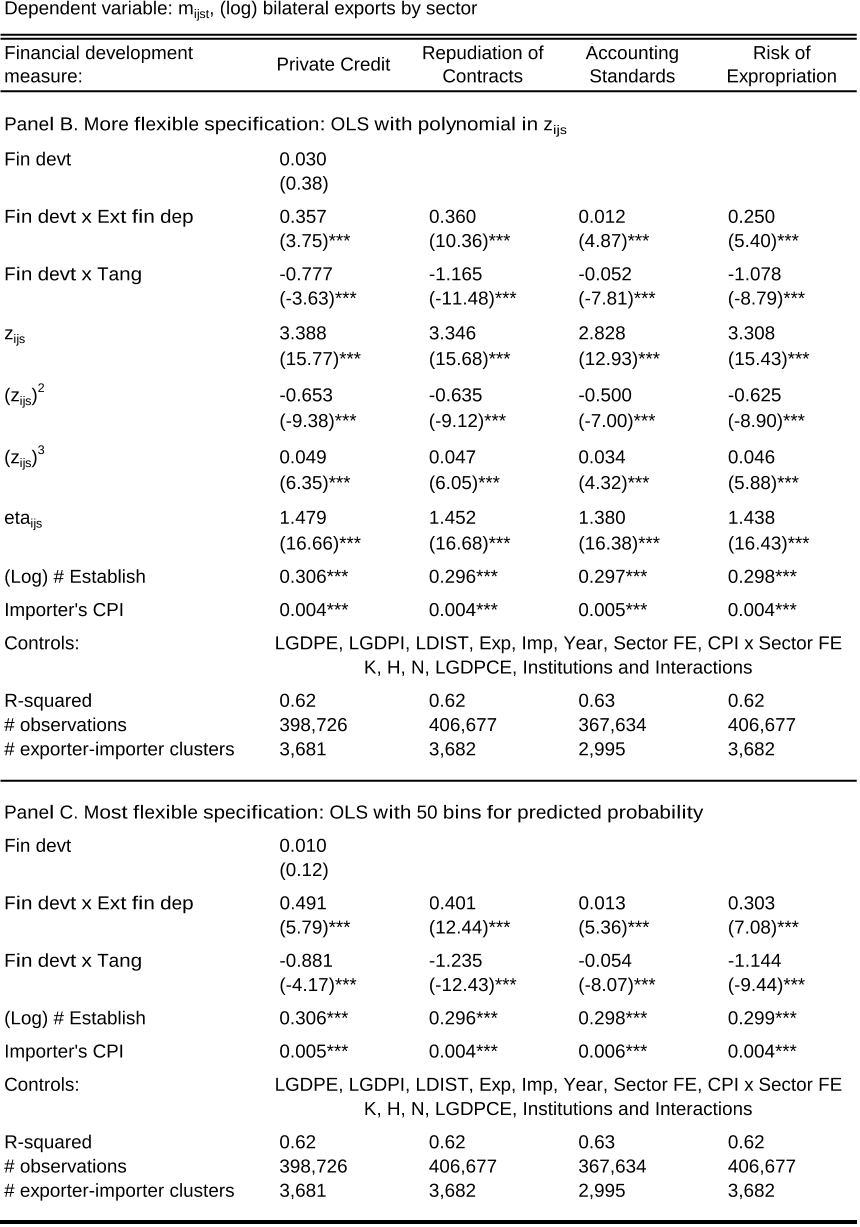Credit Constraints, Heterogeneous Firms and International Trade
Reads0
Chats0
TLDR
This article examined the detrimental consequences of financial market imperfections for international trade and developed a heterogeneous-firm model with countries at different levels of financial development and sectors of varying financial vulnerability.Abstract:
This paper examines the detrimental consequences of financial market imperfections for international trade. I develop a heterogeneous-firm model with countries at different levels of financial development and sectors of varying financial vulnerability. Applying this model to aggregate trade data, I study the mechanisms through which credit constraints operate. First, financial development increases countries' exports above and beyond its impact on overall production. Firm selection into exporting accounts for a third of the trade-specific effect, while two thirds are due to reductions in firm-level exports. Second, financially advanced economies export a wider range of products and their exports experience less product turnover. Finally, while all countries service large destinations, exporters with superior financial institutions have more trading partners and also enter smaller markets. All of these effects are magnified in financially vulnerable sectors. These results have important policy implications for less developed economies that rely on exports for economic growth but suffer from poor financial contractibility.read more
Figures

Table 10. Economic Significance: Predicted vs. Actual Trade Growth 
Table 9. Economic Significance: Comparative Statics 
Table 5. Financial Development and Firm-Level Exports 
Figure 3. The Productivity Cut-off for Exporting 
Table 5. Financial Development and Firm-Level Exports 
Table 1. Export Patterns in the Data
Citations
More filters
Dissertation
Three essays on firm investment, trade credit, and exports
Mansilla Fernández,José Manuel +1 more
TL;DR: Tesis Univ Granada Programa Oficial de Doctorado (OFD) as mentioned in this paper was used for the evaluation of the competitividad económica of companies.
Journal ArticleDOI
A tale of two countries: Directed technical change, trade and migratory movements
TL;DR: In this article, the authors propose a North-South model that reconciles trade and production strategies, flows of innovators and the path of economic divergence, or convergence, between countries, and show how the technological and economic gaps can be reversed if southern countries stop imitating northern goods and, instead, produce complementary goods.
Journal ArticleDOI
Financing benefit from exporting: An indirect identification approach
Ziliang Yu,Jiadong Tong +1 more
TL;DR: In this article, an indirect identification strategy with application to Chinese privately owned enterprises (POEs) is proposed, and the authors examine whether and how firms obtain such financing benefits from exporting and find that although exporting can alleviate financial constraints, it does so mainly through the mechanism of sales diversification.
Posted Content
Exporting and Firm-Level Credit Constraints-Evidence from Ghana
TL;DR: In this paper, the authors model how firms finance their fixed costs of exporting through internal financing from retained earnings and external financing (borrowing from banks) and predict that credit access has a positive impact on firms' export propensity and that this effect is only signifincant form firms in the intermediate range of producitivity.
Journal ArticleDOI
Access to finance and the exchange rate elasticity of exports
TL;DR: In this paper, the authors used Chinese firm-level data to show that exporting activities by more financially constrained firms are more sensitive to exchange rate changes than those by firms with a better ability to raise external capital.
References
More filters
Posted Content
Law and Finance
Rafael La Porta,Rafael La Porta,Florencio Lopez de Silanes,Florencio Lopez de Silanes,Andrei Shleifer,Andrei Shleifer,Robert W. Vishny,Robert W. Vishny +7 more
TL;DR: This paper examined legal rules covering protection of corporate shareholders and creditors, the origin of these rules, and the quality of their enforcement in 49 countries and found that common law countries generally have the best, and French civil law countries the worst, legal protections of investors.
Journal ArticleDOI
Law and Finance
TL;DR: In this article, the authors examined legal rules covering protection of corporate shareholders and creditors, the origin of these rules, and the quality of their enforcement in 49 countries and found that common-law countries generally have the strongest, and French civil law countries the weakest, legal protections of investors, with German- and Scandinavian-civil law countries located in the middle.
Journal ArticleDOI
The Impact of Trade on Intra-Industry Reallocations and Aggregate Industry Productivity
TL;DR: This paper developed a dynamic industry model with heterogeneous firms to analyze the intra-industry effects of international trade and showed how the exposure to trade will induce only the more productive firms to enter the export market (while some less productive firms continue to produce only for the domestic market).
Journal ArticleDOI
Finance and Growth: Schumpeter Might Be Right
TL;DR: In this paper, the authors examined a cross-section of about 80 countries for the period 1960-89 and found that various measures of financial development are strongly associated with both current and later rates of economic growth.
ReportDOI
Financial Dependence and Growth
Raghuram G. Rajan,Raghuram G. Rajan,Raghuram G. Rajan,Luigi Zingales,Luigi Zingales,Luigi Zingales +5 more
TL;DR: This paper examined whether financial development facilitates economic growth by scrutinizing one rationale for such a relationship; that financial development reduces the costs of external finance to firms, and found that industrial sectors that are relatively more in need of foreign finance develop disproportionately faster in countries with more developed financial markets.